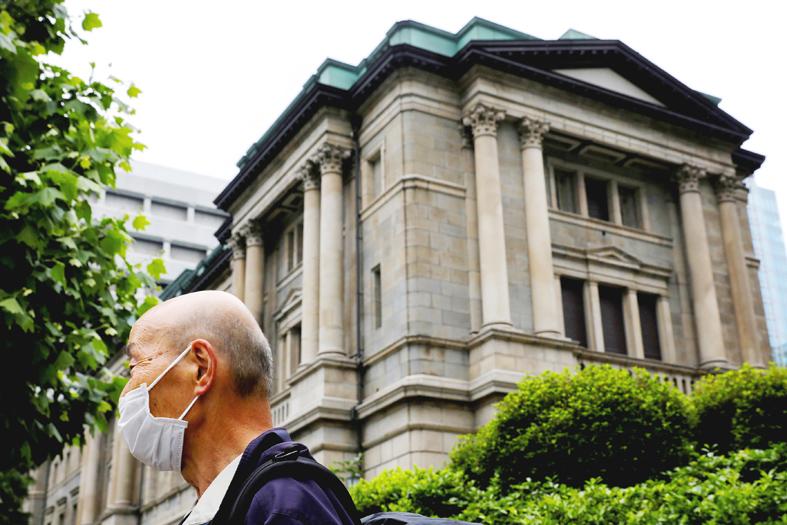The Bank of Japan (BOJ) is expected to downgrade its economic growth forecast for this fiscal year as supply constraints caused by Asian factory shutdowns cripple output and exports, sources said.
The BOJ is also likely to trim its consumer inflation forecast for the year ending in March, five sources said, which would reinforce market expectations that it will lag behind other central banks in whittling down crisis-mode stimulus measures.
The revisions would highlight the fragile state of Japan’s recovery as rising import costs and supply bottlenecks hit firms, casting doubt on the central bank’s view that strength in manufacturing profits would offset weak consumption.

Photo: Reuters
“Upcoming data will likely show a pretty big plunge in Japanese exports and output due to factory shutdowns in Asia. That will clearly push down economic growth,” said one of the sources, who spoke on condition of anonymity.
“Japan’s recovery isn’t derailed, but the timing of a clear rebound may have been delayed,” another source said.
The revisions are to be part of the BOJ’s quarterly growth and price forecasts due at its next policy meeting from Oct. 27 to 28.
While global demand remains firm, analysts expect Japan’s exports to weaken in coming months as parts shortages and factory shutdowns in Asia caused by the pandemic disrupt production for manufacturers like Toyota Motor Corp.
“We must be vigilant to the impact of supply constraints caused by supply chain disruptions in Asia,” BOJ Deputy Governor Masayoshi Amamiya said yesterday, pointing to uncertainties over the economic outlook.
BOJ policymakers are counting on an expected rebound in consumption after the government’s decision to lift state of emergency curbs on Sept. 30, but there is uncertainty on when and to what extent pent-up demand would begin to prop up growth.
Such uncertainty could force the BOJ to offer a bleaker view on the economy at this month’s meeting than the current assessment that it is “picking up as a trend,” the sources said.
After slumping 4.4 percent in the year that ended in March, Japan’s economy has been emerging from the doldrums as solid global demand moderated the hit to consumption from COVID-19 curbs.
Under current projections made in July, the BOJ expects the economy to expand 3.8 percent this fiscal year and rise 2.7 percent in the next.
That compared with forecasts of a 3.2 percent rise in fiscal 2021 and a 2.8 percent gain next year in a Reuters poll.
The central bank expects core consumer prices, which fell 0.4 percent in the previous fiscal year, to rise 0.6 percent in the current year and increase 0.9 percent in the next.
Analysts polled by Reuters expect core consumer inflation to be flat in fiscal 2021 and rise 0.5 percent in fiscal 2022.

CHIP RACE: Three years of overbroad export controls drove foreign competitors to pursue their own AI chips, and ‘cost US taxpayers billions of dollars,’ Nvidia said China has figured out the US strategy for allowing it to buy Nvidia Corp’s H200s and is rejecting the artificial intelligence (AI) chip in favor of domestically developed semiconductors, White House AI adviser David Sacks said, citing news reports. US President Donald Trump on Monday said that he would allow shipments of Nvidia’s H200 chips to China, part of an administration effort backed by Sacks to challenge Chinese tech champions such as Huawei Technologies Co (華為) by bringing US competition to their home market. On Friday, Sacks signaled that he was uncertain about whether that approach would work. “They’re rejecting our chips,” Sacks

Taiwan’s exports soared 56 percent year-on-year to an all-time high of US$64.05 billion last month, propelled by surging global demand for artificial intelligence (AI), high-performance computing and cloud service infrastructure, the Ministry of Finance said yesterday. Department of Statistics Director-General Beatrice Tsai (蔡美娜) called the figure an unexpected upside surprise, citing a wave of technology orders from overseas customers alongside the usual year-end shopping season for technology products. Growth is likely to remain strong this month, she said, projecting a 40 percent to 45 percent expansion on an annual basis. The outperformance could prompt the Directorate-General of Budget, Accounting and

NATIONAL SECURITY: Intel’s testing of ACM tools despite US government control ‘highlights egregious gaps in US technology protection policies,’ a former official said Chipmaker Intel Corp has tested chipmaking tools this year from a toolmaker with deep roots in China and two overseas units that were targeted by US sanctions, according to two sources with direct knowledge of the matter. Intel, which fended off calls for its CEO’s resignation from US President Donald Trump in August over his alleged ties to China, got the tools from ACM Research Inc, a Fremont, California-based producer of chipmaking equipment. Two of ACM’s units, based in Shanghai and South Korea, were among a number of firms barred last year from receiving US technology over claims they have

BARRIERS: Gudeng’s chairman said it was unlikely that the US could replicate Taiwan’s science parks in Arizona, given its strict immigration policies and cultural differences Gudeng Precision Industrial Co (家登), which supplies wafer pods to the world’s major semiconductor firms, yesterday said it is in no rush to set up production in the US due to high costs. The company supplies its customers through a warehouse in Arizona jointly operated by TSS Holdings Ltd (德鑫控股), a joint holding of Gudeng and 17 Taiwanese firms in the semiconductor supply chain, including specialty plastic compounds producer Nytex Composites Co (耐特) and automated material handling system supplier Symtek Automation Asia Co (迅得). While the company has long been exploring the feasibility of setting up production in the US to address